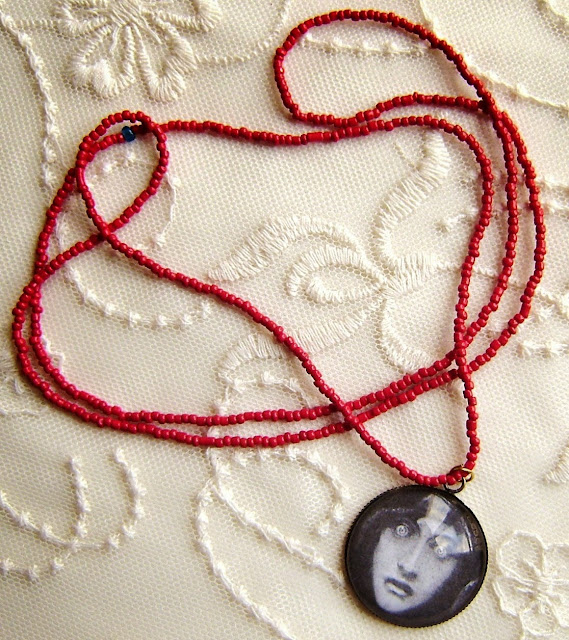Medusa is the apotropaic par excellence.
Two staring eyes. A talisman.
From the second half of 19th
century, the central-european world of literature and art assisted to the
turning feminine of the anti-hero character. Moreover, in this period
mythological –and archetypical- figures as Medusa, Sphinx or Salomé were all considered
and represented as different sides of the same coin: no longer an ancient myth,
but something present and actual, in a conception that would have given birth
to the myth of the Femme Fatale,
referring to the modern society woman who can be at the same time more
emancipated, hyper-attractive and pitiless destructive, conducting the male to
death or madness.
Just to take some important examples of this symbolist current: Gustave Moreau, L’apparition (1876, Paris, Musée d’Orsay), Jean Delville, L’idole de la Perversité (1891, private collection), Franz Von Stuck, The Sin (1893, Munich, Neue Pinakothek) and The kiss of the Sphinx (1895, private collection), Arnold Böklin, Shield with the head of Medusa (1897, Paris, Musée d’Orsay), Paul Dardé, Eternelle douleur (or Tête de prostituée, 1913, Paris, Musée d’Orsay).
Just to take some important examples of this symbolist current: Gustave Moreau, L’apparition (1876, Paris, Musée d’Orsay), Jean Delville, L’idole de la Perversité (1891, private collection), Franz Von Stuck, The Sin (1893, Munich, Neue Pinakothek) and The kiss of the Sphinx (1895, private collection), Arnold Böklin, Shield with the head of Medusa (1897, Paris, Musée d’Orsay), Paul Dardé, Eternelle douleur (or Tête de prostituée, 1913, Paris, Musée d’Orsay).
+

G. Moreau, L'apparition, 1876

F. Von Stuck, The Sin, 1893
Particularly, the head of Medusa
screaming and surrounded by snakes is represented as a desperate, strong and
powerful icon that petrifies anyone looking at her directly in her hypnotic
eyes. Having been a beautiful maid, she has undertaken this horrible metamorphosis
after the rape by Poseidon in the temple
of Athena. A victim who
becomes persecutor.
Between the end of the 19th
and the beginning of the 20th century, Medusa’s iconography
confirmed itself as the perfect support for an art who aimed to oblige the spectator
to face his own, secret and most intimate fears, being at the same time an
amulet for them.
Finally, in a 1940’s study by Sigmund Freud, Das Medusenhaupt (Medusa’s Head), she’s presented as “the supreme talisman that provides the image of castration –associated in the child’s mind with the discovery of maternal sexuality- and its denial”.
I’ve selected this particular theme at the very beginning of this blogging voyage because of my fascination for decadent, symbolist, Munich- and Vienna-Secession art and because I want to start with a powerful image. Last spring I’ve been at a great exhibition hosted in the Musée d’Orsay in Paris, L’ange du Bizarre. Le romantisme noir de Goya à Max Ernst (5.3.2013-9.6.2013), in which the anti-hero figure was central and deeply investigated.
The inspiration has gone by, and so my creation.
I’ve been looking for an image that had to be not only descriptive, but most of all iconic. So, between tons of representation I’ve chosen Von Stuck’s one (1892).
It is perfect: a pale face emerges from the dark background, and two shiny, wide-open eyes are blocked forever in an archetypical expression that’s contemporarily scaring and deeply fascinating.
Finally, in a 1940’s study by Sigmund Freud, Das Medusenhaupt (Medusa’s Head), she’s presented as “the supreme talisman that provides the image of castration –associated in the child’s mind with the discovery of maternal sexuality- and its denial”.
I’ve selected this particular theme at the very beginning of this blogging voyage because of my fascination for decadent, symbolist, Munich- and Vienna-Secession art and because I want to start with a powerful image. Last spring I’ve been at a great exhibition hosted in the Musée d’Orsay in Paris, L’ange du Bizarre. Le romantisme noir de Goya à Max Ernst (5.3.2013-9.6.2013), in which the anti-hero figure was central and deeply investigated.
The inspiration has gone by, and so my creation.
I’ve been looking for an image that had to be not only descriptive, but most of all iconic. So, between tons of representation I’ve chosen Von Stuck’s one (1892).
It is perfect: a pale face emerges from the dark background, and two shiny, wide-open eyes are blocked forever in an archetypical expression that’s contemporarily scaring and deeply fascinating.

F. Von Stuck, Medusa, 1892
The long necklace is conceived as a
simple medal with a shiny resin cabochon and a thin wire of small scarlet beads
in Murano glass paste, referring to the blood that spurted from the neck after
her beheading by Perseus and the consequent creation of the corals in the Red Sea.

Medusa cabochon sautoir, preliminary sketch
Photos © Francesca Zabarella
Photos © Francesca Zabarella






No comments:
Post a Comment